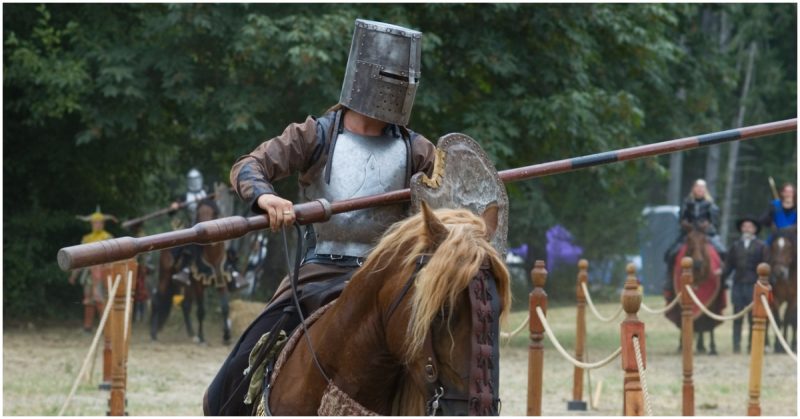The heart of the high medieval army was its knights and men-at-arms, heavily armoured soldiers from wealthy backgrounds who often fought from horseback. Using lances for high impact charges, and other weapons for close combat, they could be a devastating strike force. Much of their training came from tournaments – organised military games. These took a variety of forms.
Joust a Plaisance
Jousting was the most formalised part of medieval tournament combat. Two mounted knights faced each other down a long stretch of open ground, often with a low fence between them. Mimicking their role in a cavalry charge, they road as hard and as fast as possible at each other, each with the aim of knocking the other from his horse. Shields were normally worn, and were usually the target for lances, as this created a chance to knock another knight down without badly injuring him. As armouring technology improved, plate armour provided a similar target.
The joust a plaisance was a sporting tournament in a form we would recognise today. Over several days, knights would face each other ono-on-one in the lists – the jousting space. Several passes were made against each opponent, to the excited cheering of spectators. One by one, men were knocked out of the competition, until a winner could be proclaimed.
Though the most formal and least warlike of the tournament games, the joust a plaisance could still be fatal. Lances could hit bodies, or splinter and get into the targets’ faces. In 1130, Pope Innocent II went so far as to forbid Christian burials for those killed in tournaments, in an attempt to end the bloody sport.
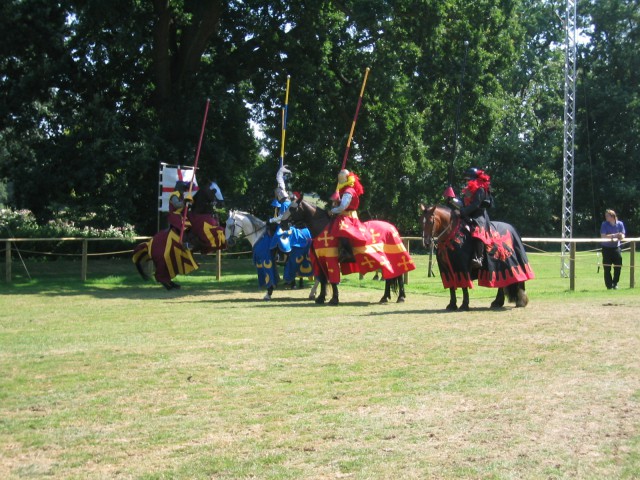
Challenge to Arms
Grand tournaments were expensive events. Not everyone could afford to participate, let alone to organise one. Ordinary knights therefore found a way to arrange their own small tournaments, called challenges to arms.
Imitating the passages of arms of their wealthy superiors, these knights would put out a challenge for others to meet them in a particular way for organised combat. For example, in 1390 four knights took to the lists at St Inglevert in France, declaring that they would take on all challengers.
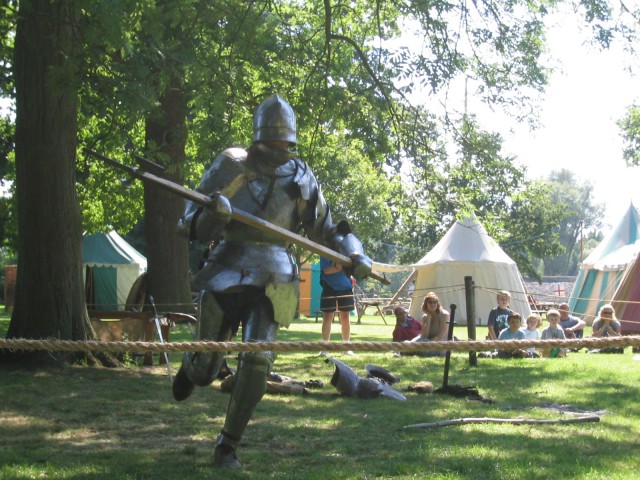
These contests were sometimes a chivalrous addition to the messy business of war. In 1398 seven French knights put out a challenge to the knights of England, with whom they were then fighting the Hundred Years War. They would wear a diamond symbol on their armour for three years, during which time English knights were welcome to challenge them to one-on-one combat. This would start with the lance, just like an organised joust, then be followed by sword, axe and dagger. Stakes were specified for what the victor would win from the loser.
Melee a Cheval
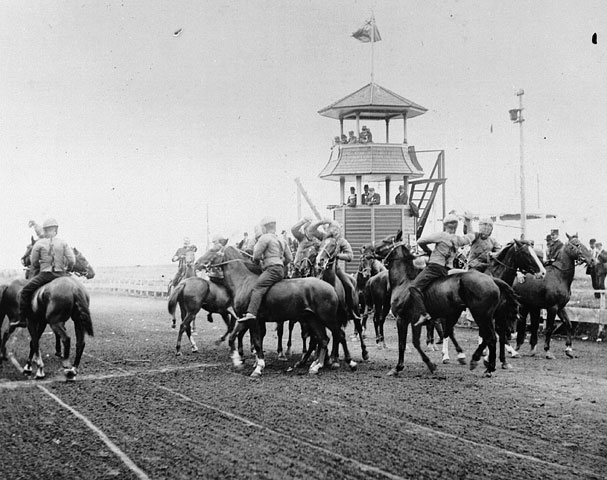
The origins of tournaments lay in the less formal wargames of the Franks, the nation that dominated western Europe under Charlemagne in the 9th century. They carried out mock battles across the countryside of northern France, as preparation for war.
Over time, these battles were brought into enclosed areas, where they would do less damage and could be more easily observed. This developed into the melee a cheval, a mounted combat between two forces of knights. Lining up on opposite sides of a designated tournament ground, they would charge at each other with lances while trying to maintain their formations. After the initial impact they would turn and fight individually or in smaller groups, while squires provided spare lances from the side lines.
The melee a cheval created an opportunity to practice something closer to real mounted combat than the joust. It was also like real warfare in that it often affected civilians, spilling out of the tournament ground and into the surrounding town or countryside.
The word tournament probably comes from the French tournament, meaning turning, reflecting the way knights turned to face their opponents after the initial melee charge.
Melee a Pied
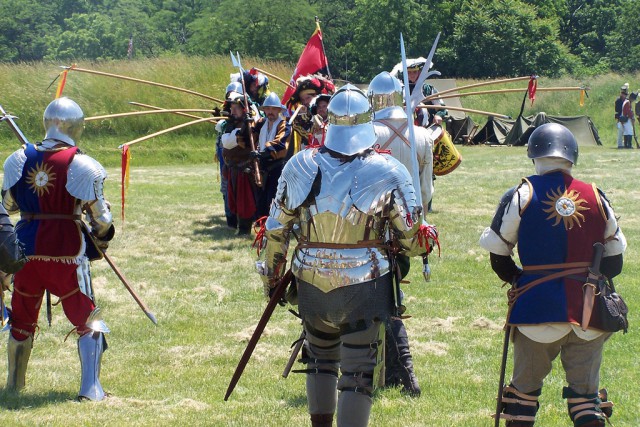
Combat on foot was a feature of some tournaments, reflecting the reality of war. From the late 13th century onwards, infantry increasingly managed to defeat mounted men-at-arms, with such famous battles as the Scottish victory at Stirling Bridge. Men-at-arms had always had to know how to fight on foot, both for sieges and for when they became unhorsed. Now they often fought on foot from the start of the battle, as shown by the English at Crécy, Poitiers and Agincourt.
The melee a pied, or combat on foot, became a popular part of tournaments. Great nobles would sometimes invest as heavily in equipment for this as in their jousting armour. The British Royal Armouries in Leeds contain several suits of armour built specially for Henry VIII to wear in tournaments, and whose design was clearly for fighting on foot rather than from the saddle. On at least one occasion Henry ordered an expensive new suit of armour for a tournament, only to have another thrown together from the armour he already had, as the specially designed set would not be ready in time.
The Bohort
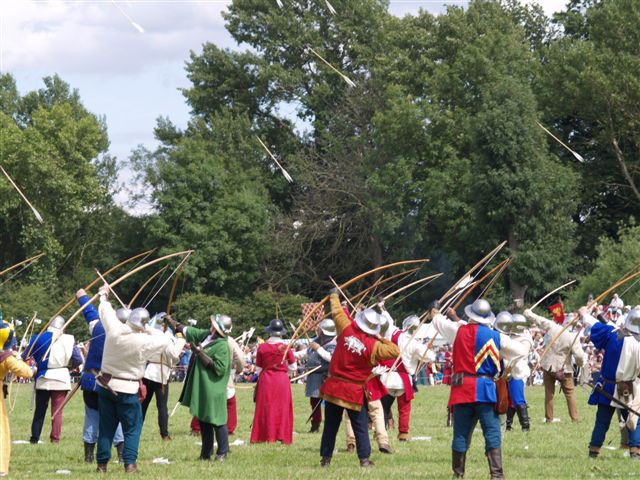
Not every tournament was a grand affair. Like the challenge to arms, the bohort provided a more informal sort of competition, and a popular one. Bohorts feature regularly in the literature of the time, where the characters celebrate knightings and weddings with these relaxed competitions.
The military skills seen in the bohort seem to have been more varied than those of other tournaments. Geoffrey of Monmouth, in his History of the Kings of Britain, describes knights throwing lances and taking part in archery contests, as well as the more familiar tournament combat. Though Geoffrey’s account is a fictional one describing King Arthur’s court, it reflects what he expected of a contemporary bohort.
The bohort was less controversial than other forms of tournament. Knights Templar, banned by the rules of their order from participating in regular tournaments, were allowed to take part in bohorts. Bohorts were also less high status events, and squires might get the chance to compete alongside knights.
